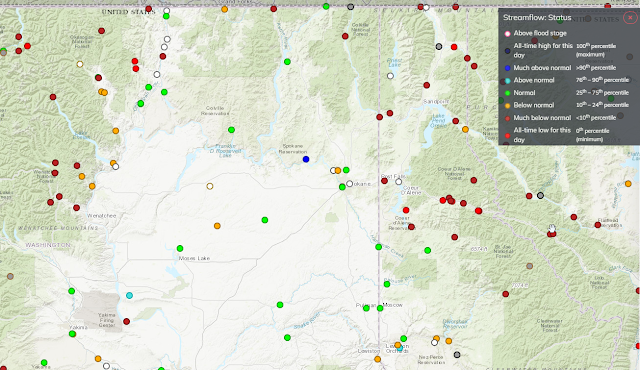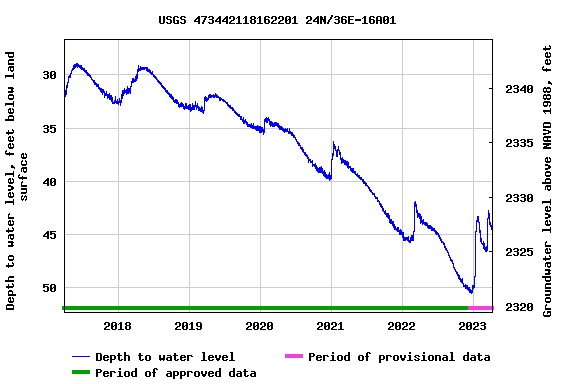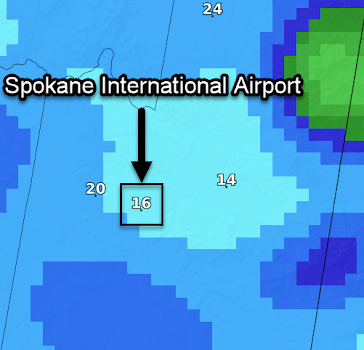Warm and wet weather is coming to the Inland Northwest. But how wet is it going to be and will the resultant precipitation result in widespread flooding? This can be answered by looking at a few things, including precipitation amounts, snow melt, and antecedent conditions. We will start by discussing the precipitation.
PRECIPITATION: The latest official forecast for Spokane is calling for 0.97" of rain over 48 hours starting 11 AM Sunday and lasting through 11 AM Tuesday. Spokane won't be the only area receiving significant rainfall, but much of the Inland Northwest will as well. This rainfall is coming from an unusually strong atmospheric river for this time of year. In fact, we could set a daily record for precipitable water values (total amount of moisture in the atmosphere) on Monday.
 |
| Atmospheric River forecast |
This event places just below the top 10 wettest (12th wettest) 48 hour stretches for Spokane (records back to 1881) in April. If 1.00" of precipitation were to occur this from Sunday morning through Tuesday morning in Spokane, the monthly total precipitation so far (1.33") would exceed the average April total (1.12") within the first 11 days. That would place the April 2023 total precipitation in the top 33% of all years by the 11th. It would also be the wettest 48 hour period the Spokane area has seen since May 20, 2020.


Probabilistic data from our weather models are useful to predict the chance of 1.00" of rain over 48 hours in Spokane early this week. The current odds of exceeding this total in 48 hours is 16% so we are forecasting on the wetter end compared to the weather models. 12 hours ago, the weather models were indicating only an 8% chance so the newer runs of the weather models have doubled the odds of greater than 1 inch or rain.
Another way that we communicate forecast uncertainty is through using a range of possibilities such as a low end amount (90% chance that there will be more rain than what is forecasted) or a high end amount (10% chance of there will be more rain than what is forecasted). The first graphic below represents the low end amount for Spokane with this event. The second graphic represents the high end amount for Spokane. Given our official forecast is calling for 0.97 inches of rain, we are forecasting on the wetter side of the model possibilities. To follow the latest official forecast, please visit www.weather.gov/spokane.
Low End Amount (90% chance of exceeding 0.3" of rain)
High End Amount (10% chance of exceeding 1.13" of rain)
SNOWMELT: The other piece of the puzzle is what what will happen to the existing snowpack? Will we melt a considerable amount of it, adding to the precipitation runoff, or will it stick around for a while? Although this might sound like an easy question the answer, it is more nuanced than you might think. Even if the temperatures get well above freezing, that doesn't necessarily mean the snow will instantly melt and runoff into the rivers. First off we need to warm the snowpack temperatures to freezing. This animation below shows the snow pack temperatures over the past week. Red colors show the snowpack temperatures around freezing and primed for melting. Notice the rapid expansion of the red over the past week over the northern third of eastern Washington, especially in the valleys below 3000-3500'.
If you look closely at this map below most of the values are well below 50%. But the problem with this map is most if not all the values in the Inland Northwest are in the mountains above 3500' and don't tell us about the density of the lower elevation snow however we can be certain the snow ratios are higher than what's seen on this map. Consequently we'd expect to see a good amount of the low level snow melting off into the nearby rivers over northeast and north-central Washington and north Idaho. But will that necessarily lead to flooding?
ANTECEDENT CONDITIONS: To help answer if we expect to see flooding, we can look at the antecedent conditions, or in other terms what's going on with the current river levels or soil moisture. Much of that can be determined by how much precipitation we've seen recently combined with how much snow melt we've seen. Over the past 3 months it has been exceedingly dry over the Inland Northwest, especially over north Idaho and extreme eastern Washington where some precipitation amounts are around half of normal.
Despite the dearth of precipitation, the much cooler than normal weather has resulted in a relatively normal snow water equivalent for this time of year. But it's a far cry from what most of the Western US has experienced this winter (widespread dark blue)
So what do you get when you have lighter than normal precipitation and a relatively normal snowpack? This means there hasn't been a significant amount of runoff into the rivers. So how light has the runoff been this Spring? Extremely light is the answer! Check out this map below for the specifics.
Notice all the red dots clustered over north Idaho into portions of northeast and north-central Washington. The dark red dots show locations that are much below normal for this time of year (10th percentile), and the bright red dots correspond to locations that are at their lowest level for the current date. These record and near record low spots include much of the Coeur d'Alene, St. Joe and Pend Oreille Basin in north Idaho and the Spokane (hidden by green dot over Hangman Creek), Okanogan, and Kettle River Basins in eastern Washington. For the Coeur d'Alene River, near Cataldo, it is at its lowest level for the date in the past 88 years!
 |
| Snow density values as of 4/8/2023 |
 |
| 90 day percent of normal precipitation |
Despite the dearth of precipitation, the much cooler than normal weather has resulted in a relatively normal snow water equivalent for this time of year. But it's a far cry from what most of the Western US has experienced this winter (widespread dark blue)
 |
| Snow Water Equivalent for 4/8/2023 |
So what do you get when you have lighter than normal precipitation and a relatively normal snowpack? This means there hasn't been a significant amount of runoff into the rivers. So how light has the runoff been this Spring? Extremely light is the answer! Check out this map below for the specifics.
 |
| Steamflow vs normal for 4/8/2023 |
Notice all the red dots clustered over north Idaho into portions of northeast and north-central Washington. The dark red dots show locations that are much below normal for this time of year (10th percentile), and the bright red dots correspond to locations that are at their lowest level for the current date. These record and near record low spots include much of the Coeur d'Alene, St. Joe and Pend Oreille Basin in north Idaho and the Spokane (hidden by green dot over Hangman Creek), Okanogan, and Kettle River Basins in eastern Washington. For the Coeur d'Alene River, near Cataldo, it is at its lowest level for the date in the past 88 years!
If we want to examine current ground water conditions, across the Columbia Basin there is a well sensor located just southwest of Davenport. Long term drought conditions have resulted in a steady drop in the water table since 2017. In fact at the beginning of the year the water table was roughly 50' below ground and the lowest this well has seen since 1992.
 |
| Well Water Table southwest of Davenport, WA |
THE FINAL VERDICT: So adding all this information up, what does this tell us? It tells us we have a lot of room in the rivers and groundwater to accommodate this upcoming rain and snow melt event. So at this point we expect this to be a largely beneficial event rather than one with destructive flooding. That's not to say there won't be any minor ponding of water in low-lying areas, but we don't expect to see any major flooding at this time. Stay tuned for updates and monitor our latest forecasts for details.



No comments:
Post a Comment